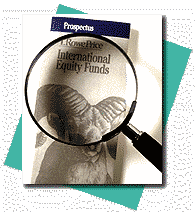
Tripod Home | New | TriTeca | Work/Money | Politics/Community | Living/Travel | Planet T | Daily Scoop
 The prospectus is a document provided by a mutual fund company to give potential investors a detailed road map of a fund - covering everything from its objective and fees to its portfolio holdings and its manager.
The prospectus is a document provided by a mutual fund company to give potential investors a detailed road map of a fund - covering everything from its objective and fees to its portfolio holdings and its manager.
The prospectus is designed to help you evaluate a fund, including the programs and policies its management uses to achieve its investment goals and the costs of investing in the fund. In fact, by law, the fund must send you a prospectus before you invest.
A summary of fees and expenses usually appears near the beginning of the prospectus. The fees can range anywhere from a low of .5 percent of assets up to 8.5 percent. Traditionally, no-load bond funds and index funds are at the bottom end of the fee range, and international equity load funds are at the top.
If the total return on a fund is reported as 8 percent, but you're paying 3 percent in combined fees, your actual return is reduced to 5 percent. And because fees aren't included in total return calculations, you have to figure out for yourself what investing in a specific fund actually costs you.
All open-end mutual funds trade stocks and bonds regularly - some more regularly than others. A fund's portfolio turnover rate reveals how much buying and selling is going on. In general, frequent turnover means higher stockbroker expenses, which means the fund needs higher returns to offset the cost.
The range of turnover rates is enormous, sometimes reaching as high as 100 percent annually. There's no rule that says whether trading frequently or infrequently works better, since both styles can produce high-performance funds.
Opening an account is easy, whether you deal directly with the mutual fund or invest through a broker or other financial advisor. All you do is fill out the application and write a check.
Most funds require minimum investments, often $1,000 to $2,500. In most cases, a higher amount is required for opening an account than for adding to it. Usually you can make additional investments of as little as $100 at a time, as frequently or infrequently as you like.
Most funds let you invest by mail, through a broker, or with automatic direct deposit from your bank account. In fact, if you agree to an automatic investment plan, the amount you must invest each time may be reduced to as little as $50.
You can reinvest the money you earn by having your distributions put back into the fund.
Or you can take the money in cash, or some combination of the two. If you're investing in mutual funds for long-term growth, you'll probably decide to reinvest.
The earnings are taxable, whether or not you get the cash, unless you're investing in a tax-exempt fund. The fund company will let you know what the earnings were at the end of each year.
Sometimes you write checks against the value of your accounts, as if it were a bank checking account. Each check may have to be for at least a minimum amount - often $500 - but you can use the checks to pay your bills, make investments, or whatever you like. Money market funds, however, are the only ones you should use this way. Redeeming stock and bond funds by check always has tax consequences since there will be a profit or loss on the investment.
As long as you sign up for the various features when you open your fund account, moving money around or taking it out is easy.
Exchange services let you transfer money from one fund to another, as long as the same name or names are on the two accounts. And there are lots of ways to get your money out of the fund, including checks, wire transfers, electronic transfers, and automatic withdrawal plans.
Map | Search | Help | Send Us Comments